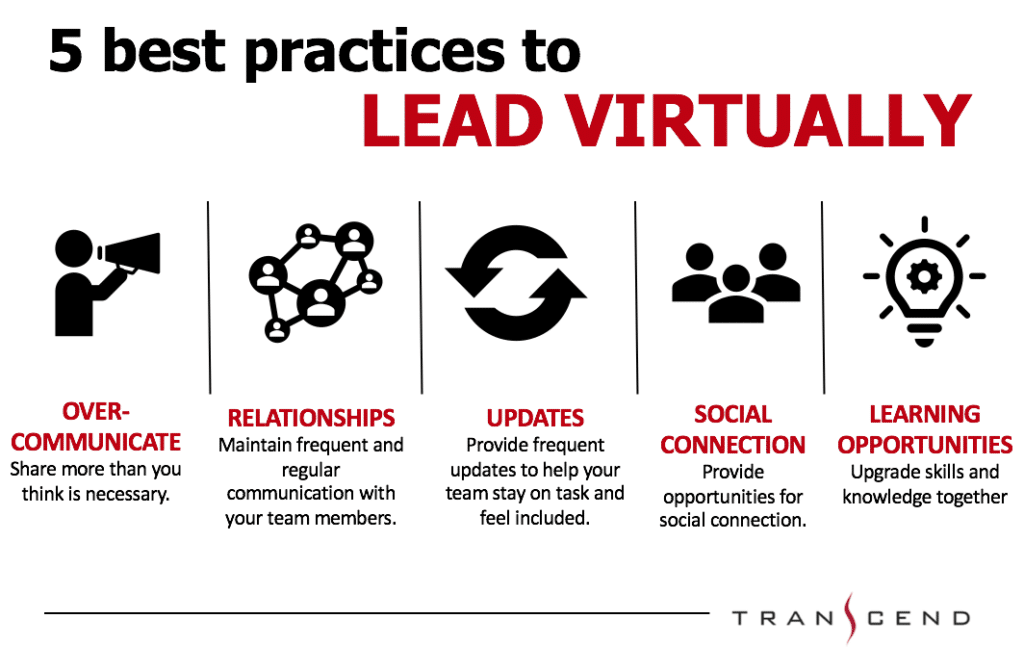31 Mar 5 Best Practices to Lead Virtually
Due to the global pandemic and to the rapid changes that have ensued over the last few weeks, many people are now working remotely. Leaders are having to lead and manage remote teams, and employees are adjusting to remote work while potentially also homeschooling their children/ juggling childcare/ working at home with their spouses. Certainly, the need to lead virtually comes with challenges. Use these best practices to help make it work for you and your organization.
The good news is that leadership itself, doesn’t change. Whether co-located or remote: people are people.
What has changed: leaders now have to be more intentional, use new tools to communicate more effectively, and set expectations clearly.
To meet the challenges of managing a geographically dispersed team, make time to plan your interactions with your team, peers, customers and other stakeholders. Disruption to work schedules and locations can cause individuals and teams to feel isolated. Consequently, focus on sharing the big picture and doing more to facilitate collaboration.
Below are our 5 best practices to leading in virtual work environments:

1. Over-Communicate:
Share more than you think is necessary, and encourage your team to do the same. Communication is key. When you are not meeting in person, it becomes even more critical because the “water cooler conversations” won’t happen and not everyone will feel comfortable asking questions on conference calls or chat.
2. Relationships
Maintain frequent and regular communication with your team. Since you don’t see your team, and they don’t see you, the casual drop-by doesn’t happen. You have to create conscious interactions to fill that void. You can do this in a scheduled group chat, or a quick call or video conference with each person once a week or even more often. Make a list of who you need to keep relationship with, and decide how to make it happen.
3. Updates
Provide updates to help your team stay on task and feel included in the day-to-day changes of the organization. Post them on your chat, wiki, website, send an email or do a group conference call or webinar. Help everyone understand the momentum and progress being made so they feel that the situation is being managed.
4. Social Connection
Provide opportunities for social connection with you, and for other team members to connect virtually as well. You will be the example they follow. You can hold a virtual coffee break, a group exercise event, a morning centering exercise or a virtual lunch or cocktail. Give your team a chance to share what’s going on in their lives to celebrate, commiserate and definitely find ways to laugh together.
5. Learning Opportunities
Use this time to upgrade skills and knowledge together. Being out of the office does not mean learning can’t happen. How can your team keep learning? What skills have you been wanting to work on? We’ve seen demand increase for feedback, conflict, remote work, and change resilience.
LEAD VIRTUALLY and CREATE TRUST
Trust and accountability will be key to leading your teams. Set clear expectations on work – What hours are we maintaining? How will we communicate? What are the mechanisms for reporting progress and challenges? Make sure you are setting crystal clear expectations with your team.
OUR FAVORITE TIPS WHEN WORKING FROM HOME
-
- Be on a schedule. Set times for work, meals, exercise, social time. 90 minute blocks work well for many people. You will feel better if you have a routine.
- Take breaks: working “virtual” does not mean working “24/7”. Plan a coffee break, lunch break, walk the dog break. Stand up, move and get some fresh air.
- Reach out and talk to others virtually. Staying physically distant does not mean staying socially distant. For your mental health, set up video calls with colleagues, friends, relatives and make MORE contact with them than usual. It’s good for you and them to help feel less isolated.
- Get fresh air – make a point of going outside for a walk, a run, a bike, or just a few deep breaths. Sunshine kills the virus, and fresh air will help you feel better. As an added bonus, being in nature calms the nervous system and will reduce your stress.
- Take care of others – finding even small ways to help others will help you feel more purposeful. Help your local small businesses, give to a charity or delivery groceries to an elderly neighbor.
Contact us for more information on how to lead virtually and our Leading Virtually Webinar. It can help leaders quickly pick up the tools needed to lead a remote workforce and keep their employees engaged.
Related Articles
Ready to fearlessly provide feedback and get positive results?
Our Fearless Leaders MasterClass® Program will help you develop the emotional intelligence and leadership skills needed to have effective conversations.
Sign up to reduce manager overwhelm and employee turnover.




